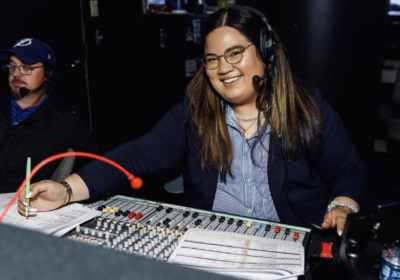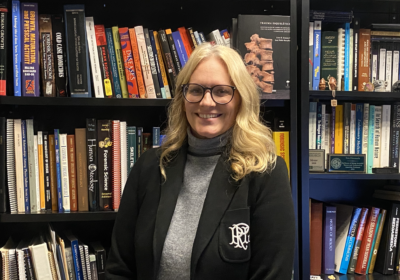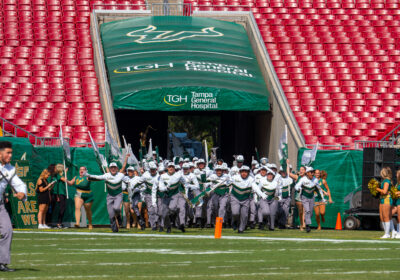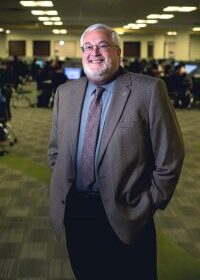An infectious trend
A roll of socks flies through the air in front of Cooper Hall. A girl, seemingly running for her life, dashes across the lawn. She’s being chased by two red-shirted zombies wearing bandanas around their heads. She’s outrunning them, and the captive audience of students sitting at picnic tables begins to cheer. She trips, and her fall is met by a collective, “Ooohhhhhh,” from the crowd. The zombies catch her and turn her into one of them.
In the past decade, there has been a pop culture obsession with the living dead. From films such as “Dawn of the Dead,” “Zombieland” and “28 Days Later” to the “Resident Evil” video games, zombies are everywhere. They’re even on campus.
The apocalypse was upon USF last week, in the form of the campus-wide tag game, Humans vs. Zombies (HvZ). Since its creation in 2005, HvZ has spread to over 650 college campuses worldwide. The game begins with one original zombie per 100 humans. Human players turn into zombies after being tagged and set out to turn everyone into the walking dead.
According to Ariana Christina, a participant in HvZ at USF, this generation’s zombie trend is a result of society’s fascination with death. As for why she plays HvZ, Christina, a sophomore majoring in creative writing, has a simple explanation.
“I know that when I play, I flash back to elementary school,” she said. “The nostalgia of running around screaming is pretty appealing.”
Last week, USF’s Humanities Institute hosted “Brain(s) Matter: Zombies in Contemporary Culture,” a conference featuring speakers who specialize in these fictional flesh-eaters.
One speaker at Thursday’s interdisciplinary panel, “Zombies 101,” brings the undead to life right here in Tampa. As the creative director and director of production/entertainment for Busch Gardens’ Howl-o-Scream, Scott Swenson chose to capitalize on the zombie pandemic with this year’s Howl-o-Scream theme – “Zombies Live Here.” According to Swenson, zombies have undeniable pop culture popularity.
“They’re versatile. Zombies can be anything, anyone, anywhere,” Swenson said. “They are scary because they are unrelenting.”
This year’s 800 Howl-o-Scream performers are transformed into flesh eaters with makeup, masks, costumes and prosthetics. The cast is made up of people from all walks of life, Swenson said, as doctors, lawyers, students and teachers all jump at the opportunity to be cast as a zombie. Zombies seem to have a universal appeal.
Maybe these doctors, lawyers, students and teachers are looking for a chance to escape from the pressures of everyday life. Zombie lovers can arguably be divided into two groups – those who like to dress/act as zombies and those who like to be scared by zombies. Either way, zombie lore has consistently relied on providing a distraction from reality.
Zombies have been gradually transforming in culture. In their first appearance in George A. Romero’s 1968 “Night of the Living Dead,” zombies were slow and uncoordinated. In 2002’s “28 Days Later,” zombies were fast and increasingly threatening.
According to Mark McCarthy, a Ph.D. candidate in communications, this change and the increased interest in zombies over the past two years represents society’s collective fears.
“Slow zombies represent a psychological fear, where fast zombies speak to a more immediate fear,” McCarthy said, and such fears could be a response to growing threats of terrorism and pandemic over the past ten years.
Daniel Lende, associate professor in the USF Department of Anthropology, discussed the popularity of zombies in video games.
“I asked my son what makes zombies good to play with,” Lende said. “And he responded: ‘They don’t shoot back.'”
The walking dead have even begun cropping up in political protests and demonstrations, most recently during Occupy Wall Street, as protestors donned their “corporate zombie” garb. In 2007, a horde of over 150 brain-eating zombies stormed an Apple Store in San Francisco in full makeup and costume as a commentary on consumerism and the growing dependency on technology.
Politics aside, zombies seem to represent an ambiguity that people are drawn to. They straddle the line between living and dead, past and present.
“It’s the escapism aspect of death,” said Stanley Deon Blackwell, an adjunct professor in the College of the Arts who has developed a Zombie Month in his Concepts & Practices course. “We then try to blur that death is absolute. With another idea of ‘undead,’ we get zombies.”
Ultimately, zombies are a familiar image in society. Their speed and appearance may evolve, but the zombie itself is unmistakable. No matter how grotesque and frightening the living dead may be, we can’t get enough of them. Zombies don’t seem to be going anywhere anytime soon, because some people will always be attracted to the unknown.
“It’s the same feeling you get on a roller coaster,” Swenson said. “It’s about the adrenaline junky. People want to be terrified, but know that, in reality, they are safe.”
– Additional reporting by Johora Ramotar






